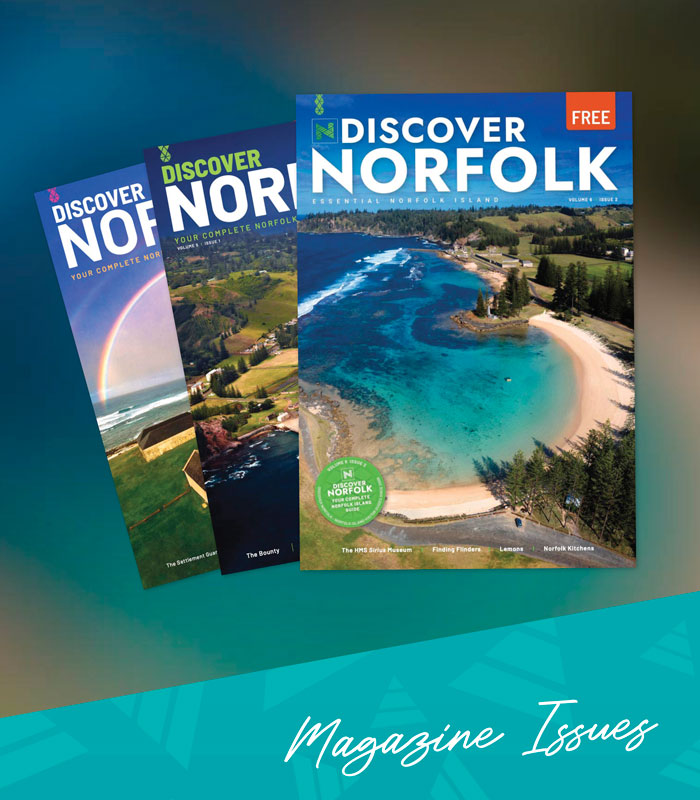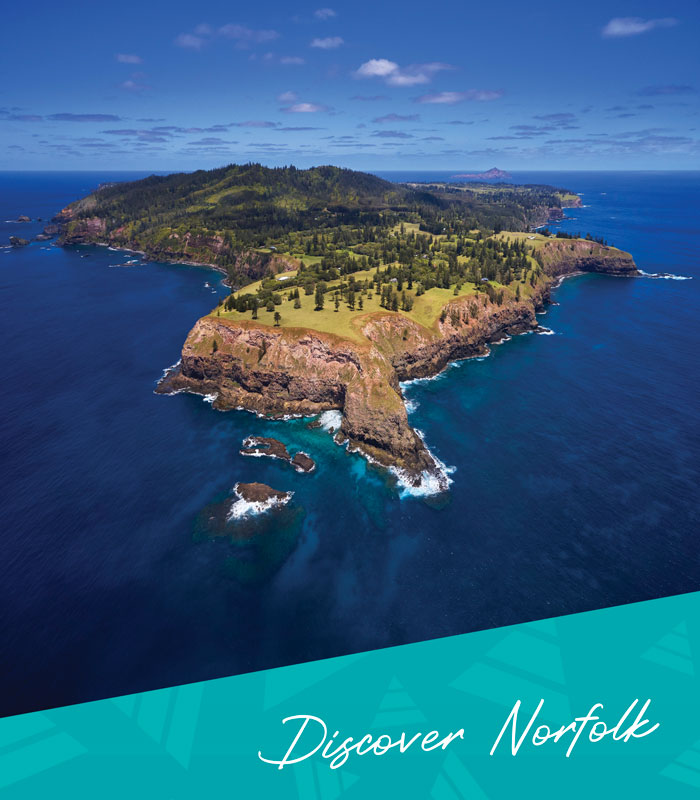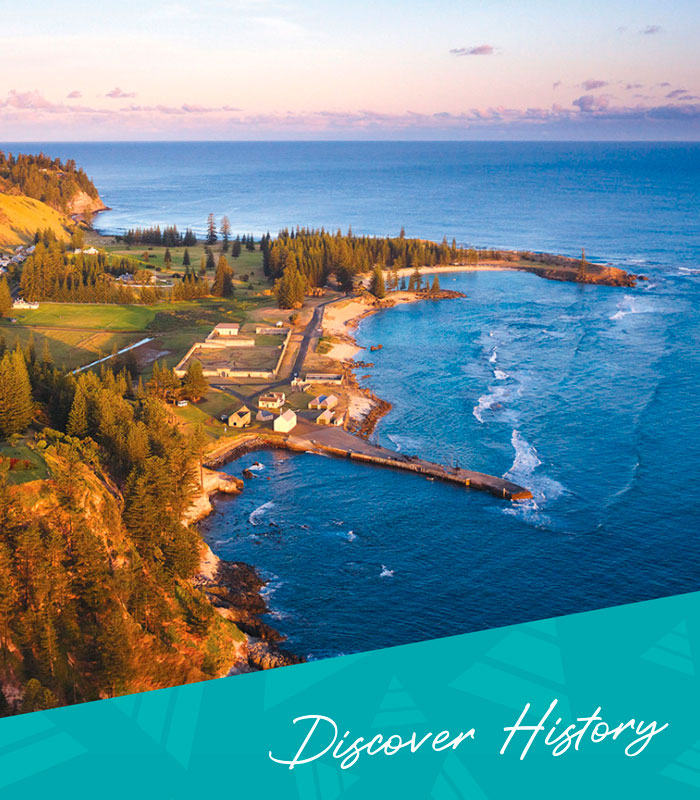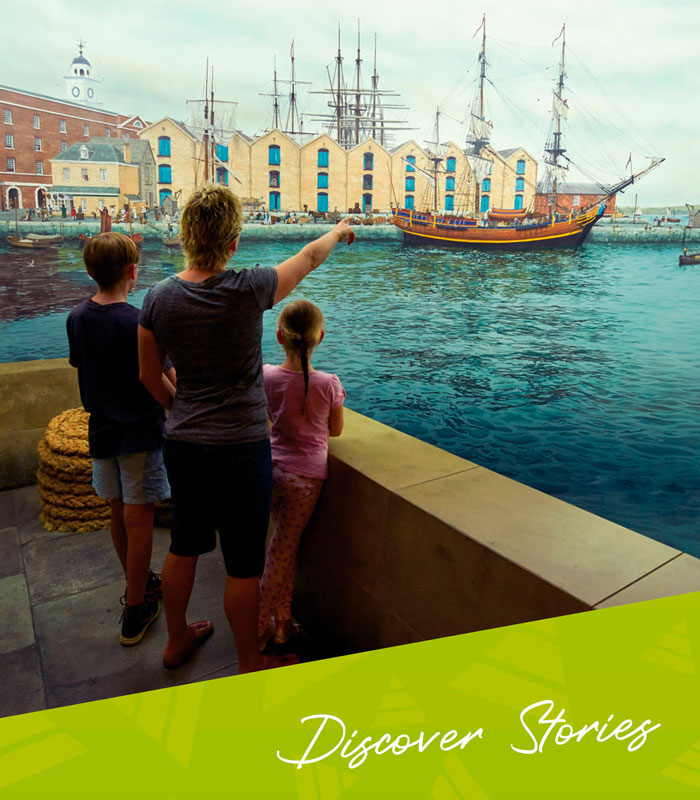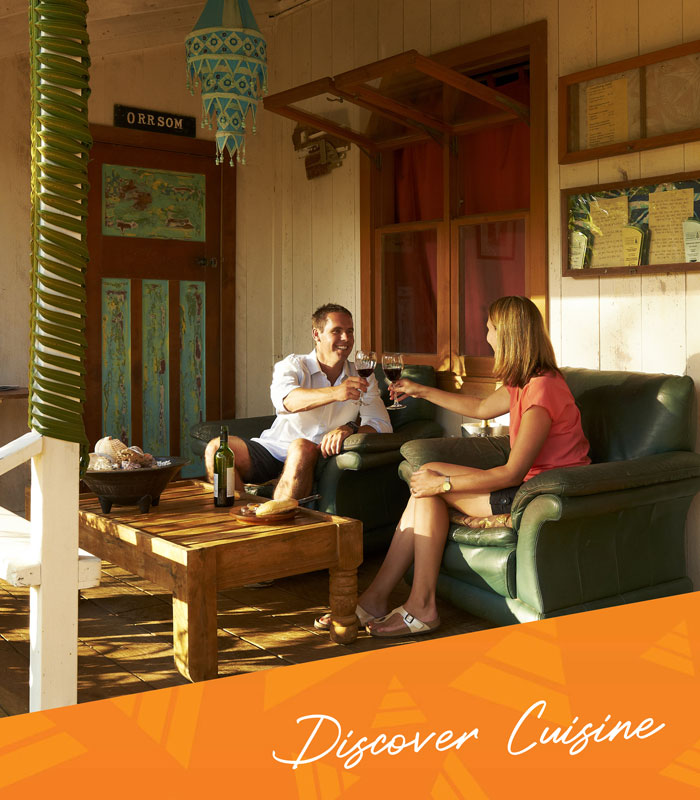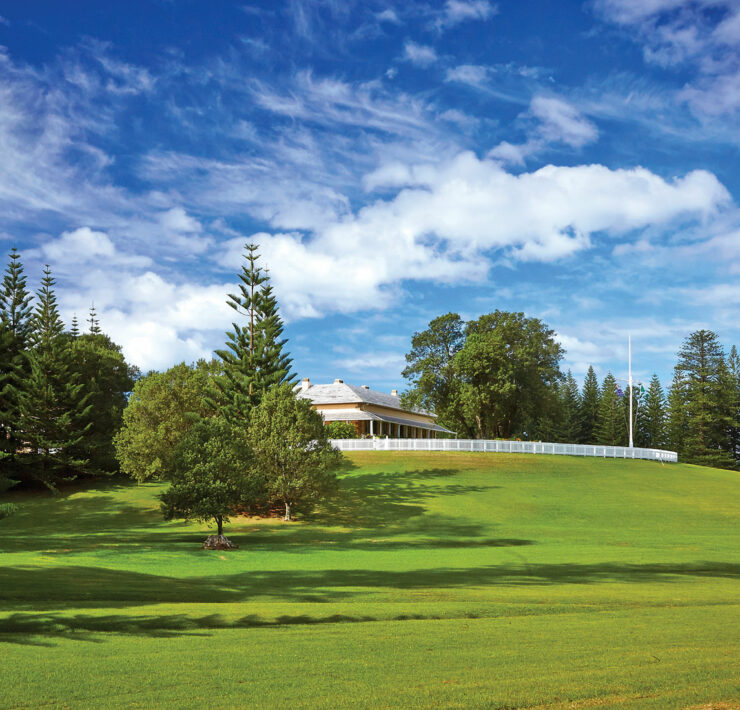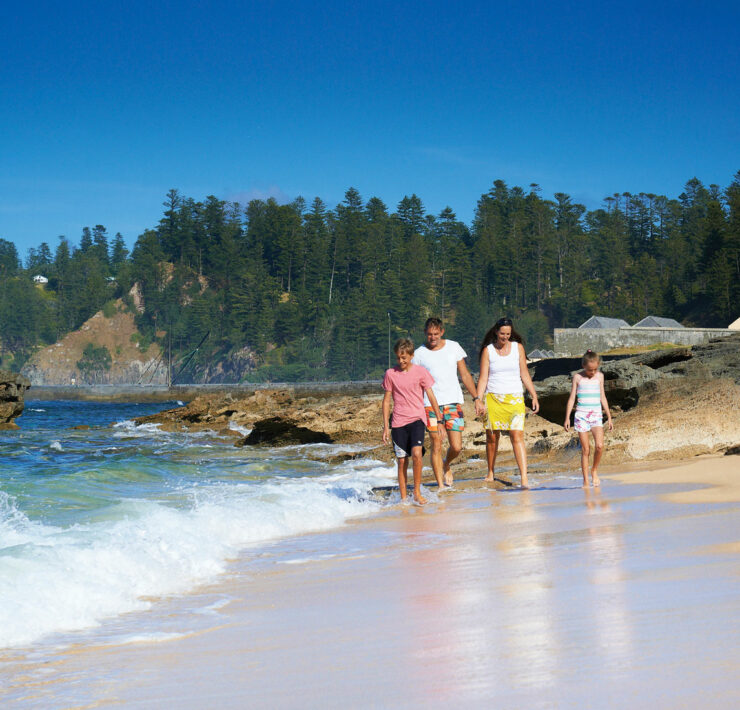
“Lemons!” smiled aproned Islanders
gathering lemons up in ar stik [the bush]
for lemon cheese, lemon pudding, lemon pie,
lemon souffle, lemon yeast for bread,
to feast upon at picnics, Anniversary,
Thanksgiving and in between.
– from Mary Duke’s poem: ‘Lemons’
______
When visitors explore this beautiful Pacific isle, they’ll notice many citrus trees; even amongst the native vegetation. Peter Coyne says the knobbly, yellowy-green ‘rough’ lemon (citrus jambhiri) …grows as a weed throughout Norfolk Island, including in the forest of the National Park. Commonly known as bush lemons, the species prospers in most parts of the world; and its hardy nature also makes it the ideal rootstock for other varieties of lemon. The sweet, thick-skinned fruit can be peeled and eaten whole (tasting like a slightly sour orange) but its tangy juice, zest and rind ensures this lemon is perfect for a wealth of sweet and savoury recipes.
Lots of different lemons, limes, oranges, mandarins and grapefruit may be found in Island gardens but the bush lemons can still be foraged from Hundred Acre Reserve, the slopes of Mt Pitt and along the Bridle Track.
Young citrus jambhiri saplings, picked up in Rio de Janeiro by the First Fleet, were introduced and cultivated on Norfolk by the original convict settlers from 1788 to 1814. As early as October 1796, Governor King reported …a great abundance of lemons. They flourished in the fertile soil and sub-tropical climate and, seeded by birds and stock, began to spread across the entire island.
Allan Cunningham, an explorer and botanist, visited Norfolk in 1830 and noted: …everywhere the lemon and guava trees [also introduced during the first penal era] exhibited their rich fruit…and he found lemons thriving all along the road between Cascade and Kingston. By 1835, Coyne asserts…lemons were growing on the very top of Mount Pitt, and their glossy, bright green leaves, spiny thorns and fragrant scent made them easy to identify. Bill Wiseman declares the Pitcairners, arriving in 1856, found a: …vast citrus forest…the trees grew everywhere: so thickly, old islanders say, you could hardly see the sky. An encyclopaedia account of Norfolk published in 1870 said: ‘…the underwood is largely composed of lemon trees.’
By 1904 J H Maiden, a noted botanist, described citrus jambhiri as …one of the principal weeds of the Island…in places its thorns present a formidable barrier to a passage through the bush. Ten years later R M Laing, another naturalist, also remarked upon the lemons, and other citrus species, growing all through Norfolk’s forested areas. Even casual visitors to the Island were amazed by their spread. The Murrell sisters came ashore in June 1914 and Bertha Murrell wrote in her diary: …we followed…the winding track up and down steep inclines …marvelling to find ourselves in a forest composed of lemon trees run wild – laden with fruit… Returning to Norfolk later in 1914, for an extended stay, Bertha observed: Wherever we go we find thickets of lemons tangled up with yellow guavas, native oak [and] bloodwood…
In late November she wrote: …we joined the lemon picking party…Five hours work, by four pickers, resulted in about 3,000 pounds of lemon…and all this is growing wild everywhere on all the uncleared land, and all along the roadside…Agents here are supplied with casks, holding somewhere about 32 gallons I believe, and machinery for cutting the lemons in half and extracting the juice…the two agents between them sent off 100 casks; this gives some idea of the immense quantity growing wild. By April, 1915 Bertha notes: We sadly miss the wealth of lemons everywhere we wander – since they became marketable, they no longer colour the bush and roadsides yellow. No less than 360 casks of juice went off by last steamer…
Three months later Bertha wrote: Lemon picking has begun again in full force. The first day one buyer had a hundred thousand brought in and, getting blocked, had to stop buying for the day. Three of our household started at about 12 o’clock and by 5pm had 9,600 gathered from 3 or 4 trees. Four shillings per thousand is this year’s price; so that, low as that seems, it brings in a good amount of money to the Island.
A few weeks after this Bertha and her sister, Laura, went picking with locals as a wartime fundraiser: Our day’s ‘lemoning’ resulted in a total of 21,600 lemons… We two worked hard from 9am ‘til about 5pm with a big band of women and a few young men, [and] horses and carts were brought to carry the fruit to the squeezers.
According to the Norfolk Island Museum: …between 1914 and 1916, a number of Australian companies such as the United Condiment Company and Wilson & Co [set up] several lemon factories on the Island…In 1916 Elsie Adams went to Sydney where she engaged Count Giovanni Pulle [a wealthy Sydney newspaper proprietor] to help with the establishment of a lemon peel factory. [The following year] some 901 casks of lemon juice and 1,121 casks of peel were exported. This represented about 4 million lemons.
The Museum believes this trade: …suffered when the frequency of shipping by Burns, Philp & Co was seriously reduced; making… [the business] unprofitable. However, … [they] limped on and, once shipping services resumed after the war, boomed again. In late 1919 over one quarter of residents, or two thirds of the Island’s labour force, were involved in the lemon industry.
Bill Wiseman was told: A man could pick five thousand lemons a day, packing them into three-bushel sacks supplied by the factory manager, holding 200 lemons each…Technique was simple: ‘You’d get a pole with a hook on the end, put it over the branch and shake like hell!’ The fruit was then carted to small processing plants all around Norfolk where the juice was extracted using a lever operated press.
Wiseman says: The press frame was placed over an empty 72-gallon cask and the operator put his first lemon in the centre of the slotted board in the middle of the frame. He brought down the cricket-bat shaped lever, with a knife set in it, and the blade sliced through the lemon and sank into the slot. The face of the bat squeezed the lemon halves dry and the juice ran into the slot, around the blade, and into the barrel. Then the operator did it again…and again…until the cask was full. It took a good man, working from eight in the morning until five in the afternoon, pressing one or two lemons at a time, to fill the cask.
In 1921 The Sydney Mail reported: …Little factories, family concerns, are dotted all over the island. These factories are usually roughly-constructed wooden buildings divided into a room with long rows of sorting bins, another room for cutting and squeezing frames, and another holding great vats of brine, in which are stored and soaked the peel before it is casked.
During the lemon season, and that is most of the year, Norfolk is a busy place…outside the factories are great golden heaps of lemons waiting to be sorted. Inside there is…much chattering and laughter from eager, busy workers cutting and squeezing the fruit…deep troughs are running high with the golden juice… thousands upon thousands are cut and squeezed, and stacks of peel brined in a day…millions of lemons are used up [but] …millions of lemons [are] still going to waste.
Eventually, however, the cost of freighting the casks to overseas buyers worked against the expansion of local lemon factories. Delays due to rough seas, irregular shipping and bad weather often impacted on the quality and price of Norfolk’s lemon products and the Norfolk Museum asserts: …the industry finally died in the early 1920s from a glut that developed in the Sydney market, and exports ceased. Mainland citrus growers and processors were closer to Australian companies and were able to supply them with cheaper, and sometimes superior, juice and peel.
Despite the end of the export trade, citrus trees still thrived here. The Tully sisters lived on Norfolk from 1925 to 1935 and fondly remembered: …the wild lemon that grew in profusion on the slopes of Mount Bates and Pitt; [our mother] Lesley used the fruit for making lemon honey and cool drinks on hot days.
Then, in the early 1940s, Norfolk’s citrus crops began to be affected by a strange ‘sooty’ disease, possibly spread by introduced black ants, which decimated tree numbers. Wiseman suggests pre-fabricated buildings, imported for New Zealand troops stationed on Island during World War II, were infested with ants which carried the blight. He says: A mature tree affected by the mysterious soot can be cut back heavily, and so rejuvenated to bear again, but eventually becomes sooty once more and dies back…Within a generation the endless citrus grove dissolved, leaving the few scattered survivors.
Today Norfolk’s lemon forests, bearing fruit in wonderful abundance, are gone but some tenacious old trees survive. Those wanting to gather their juicy, pip-filled fruit can go up the mountain, or to other ‘secret spots’, to find them. They are highly prized by Island cooks – Tahitian fish, lemon butter, margaritas and sweet, tangy pies are not the same unless fragrant, wild lemons are used – and their tart, zesty flavour can’t be beaten.
___
A note from the author: I relied on three main sources for this article: Norfolk Island’s Fascinating Flora by Peter Coyne (2011), Living on Norfolk Island by Bill Wiseman (1977) and Norfolk Island 1914-1916 (Bertha Murrell’s Diary) Edited by Shane Quintal (2022). Peter Coyne helped establish our National Park in 1984 and has a great knowledge of Norfolk’s plants and wildlife. The late Bill Wiseman, after talking to old-timers in the 1970s, wrote a book documenting local customs and folklore; and Bertha Murrell kept a detailed diary of Island life during World War One.
______
Image Credit: Norfolk Island Museum
____
Article content disclaimer: Article first published in Discover Norfolk, Volume 06 Issue 02, 2023. Please note that details of specific travel, accommodation and touring options may be outdated. References to people, places and businesses, including operating days and times may be have changed. References to Government structure and Government businesses/entities may no longer be applicable. Please check directly with businesses and/or Government websites directly rather than relying on any information contained in this article before you make travel arrangements.


